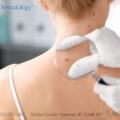Tues: 8:30am - 3:00pm
Wed: 12:00pm - 6:00pm
Thurs: 8:30am - 3:00pm
Fri: Closed
Sat: 8:30am - 12:30pm
Sun: Closed
Greenvale, NY 11548
How Long Does it Take for Brown Spots to Fade after IPL?


So you’re ready for your first IPL treatment. By now your dermatologist or aesthetician should have explained the procedure and the potential for results. Then come the questions.
The first question on the minds of many people who pursue IPL or photofacial therapy is frequently, “How soon will I see results?” Or, to put it another way, “How long does it take for these brown spots to fade away!?”
Let’s look at some different scenarios to provide the best possible answer to that question as it applies to different skin conditions.
IPL stands for Intense Pulsed Light, also known as photorejuvenation. The procedure for using IPL is commonly called a photofacial. Treatments are performed at your dermatologist’s office by a highly trained professional, usually a licensed aesthetician or a dermatologist.
IPL can be a fantastic therapy for erasing mild sun damage, freckles, and getting rid of – or greatly reducing – irregular pigmentation and light brown spots on the face, neck and chest.
Brown spots, also referred to as “lentigines” in medical terminology, will fade over several treatments. Most patients will require 4 to 6, but everyone is different. After that, some people may need occasional maintenance treatments to keep their skin looking young and healthy.
When treating brown spots (also known as hyperpigmentation) or melasma (larger areas of brown discoloration) you may see an immediate darkening of some skin around the treatment area. This is common and nothing to worry about. The temporary darkening occurs if there is brown pigment in the upper layers of your skin. The darkened area typically begins to fade in 7 to 14 days. This is when you’ll also begin to notice that many superficial brown spots around the treated area are becoming lighter, and less noticeable. They won’t vanish with one IPL treatment, but in almost all cases patients will see progress.
Fading of hyperpigmentation depends on the skin area and the type of spots being treated (sun spots, brown spots, dark spots, and age spots).
If the pigment is located deeper in the skin, which is common with melasma, you might not see any initial darkening of excess pigment after your first photofacial. To improve deeper pigment issues and brown spots, a series of treatments spaced apart by about one month each will be needed to produce healthy skin with fewer brown spots and less discoloration. It may not be possible to erase all spots and discoloration, but significantly lighter skin and improvement in overall skin health is common.
Treating melasma is more complex and time consuming because the pigmentation exists in the deeper layers of the skin. Successful treatment depends largely on the skill and experience of the individual performing IPL therapy. This is why you should go to a licensed aesthetician or dermatologist for IPL treatments. The therapy works, but it is only as good as the individual who’s operating the equipment.
With your first and subsequent IPL treatments, improvement is most noticeable starting about a week after each session. You’ll see the greatest results after 3 to 6 months if you do a series of IPL treatments spaced out about a month apart for each session. Results can vary from session to session, but the goal is steady progress. We schedule your therapy appointments about a month apart because skin cells turn over every 30 days or so. This gives your skin time to recover and produce naturally skin-smoothing collagen, which is one of the great advantages of IPL therapy.
The reason you should plan for at least five treatments is because each IPL session builds on the progress of the previous session. Over time, this non-invasive cosmetic procedure builds upon each session to produce clearer, more evenly toned skin. There’s no downtime and discomfort is minimal. These benefits are possible by spreading treatments across a period of months. This gives your skin time to heal between each therapy sessions and helps your dermatologist assess the progress being made with your therapy. Also, IPL therapy is designed to treat one skin layer at a time. Pigment discoloration can exist at different depths in your skin. Follow-up sessions enable us to treat these deeper layers of your skin to produce the best results.
You will play a vital role in your own treatment. By following your aesthetician’s or dermatologist’s advice and taking sensible precautions, you can maximize the success of IPL therapy.
Perhaps the single most important thing you can do is stay out of the sun for at least 2 weeks before and after each treatment. This avoids any adverse reaction related to therapy. Here are other guidelines your dermatologist will recommend that you follow to get the best possible results from your IPL treatments.
Speed up healing after IPL therapy:
- Use mild cleansers and moisturizers daily on your skin.
- Apply a sunscreen with a minimum of 30 SPF. This protects your skin from UVB and UVA rays.
- Cleanse your skin twice a day with warm water.
- Perform a microdermabrasion facial 2 to 3 weeks after treatment with IPL. This protects and hydrates your skin while removing dead skin cells.
- Add stem cell serum to your skin regimen to boost collagen repair, and give your skin a smooth and healthy appearance.
What to avoid after IPL therapy:
- No hot showers for 48 hours.
- Avoid taking aspirin, Ibuprofen, consuming alcohol, heavy exertion and activities which may cause flushing for 2 days after treatment.
- Avoid harsh topical products such as retinols and glycolic acid products for one week after.
- Avoid direct sunlight on the treated area and use a sunscreen with SPF 30 or greater for 4 to 6 weeks after treatment.
- No swimming, especially in pools with chemicals such as chlorine.
- No hot tubbing.
- Avoid activities that cause excessive perspiration.
- Do not pick at or remove any loosening or peeling skin.
- No electrolysis, facial waxing or depilatories (hair removal products) for 14 days after treatment.
Getting the Best Photofacial Treatment
You don’t have to look far for excellent dermatology services – including IPL therapy and other cosmetic treatments. Best of all, now there’s no waiting.
In many parts of New York and throughout the country, patients often wait weeks before they can see a board-certified dermatologist and receive a diagnosis, much less actual treatment.
That’s no longer necessary.
At Walk-in Dermatology, patients can see a board-certified dermatologist who will evaluate your skin and answer all your questions. If photofacial therapy seems like the right solution for your skin condition, we will work with you to set up IPL treatments convenient for your schedule.
No more waiting days or even weeks to receive IPL treatments. If you desire a proven, non-surgical way to revitalize your appearance and treat sun damage, wrinkles and fine lines, rosacea, enlarged pores, scars and much more, Walk-in Dermatology is here to serve you. We are open and ready to help you regain healthy skin that positively glows with a youthful look.
Read more: What Are the Benefits of IPL Treatments?








